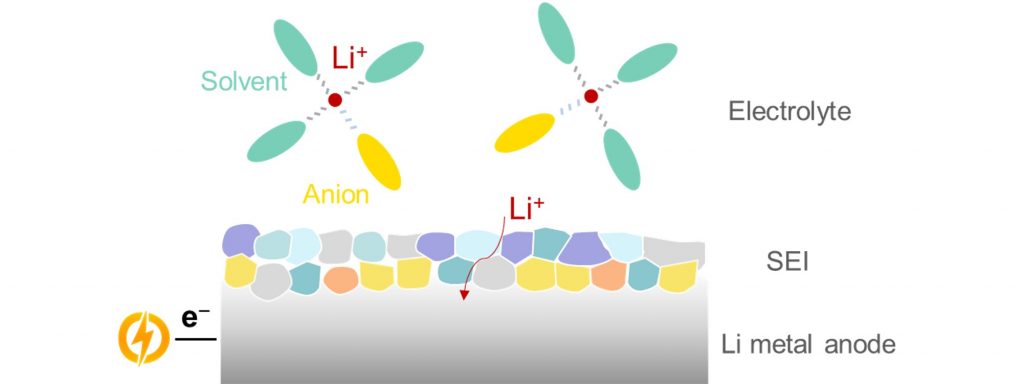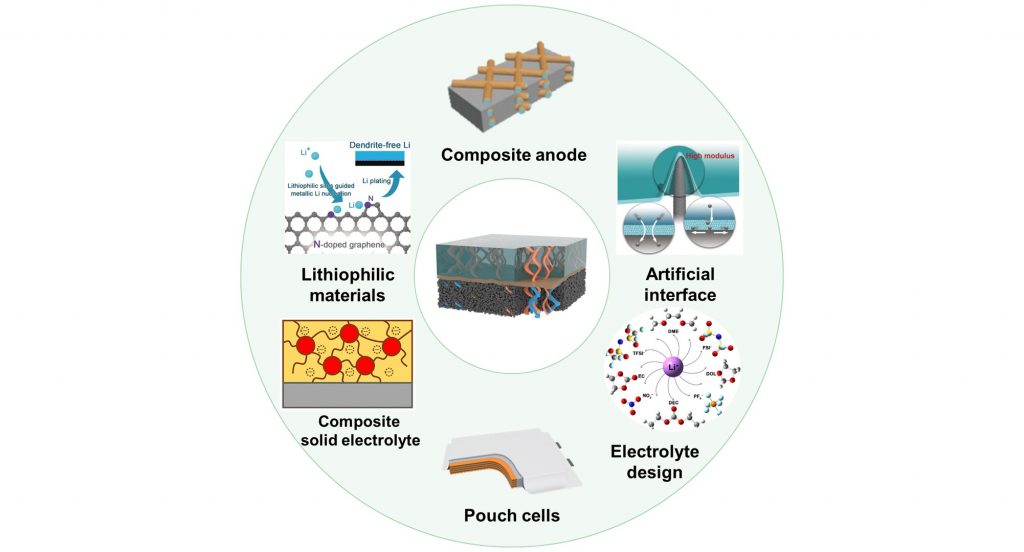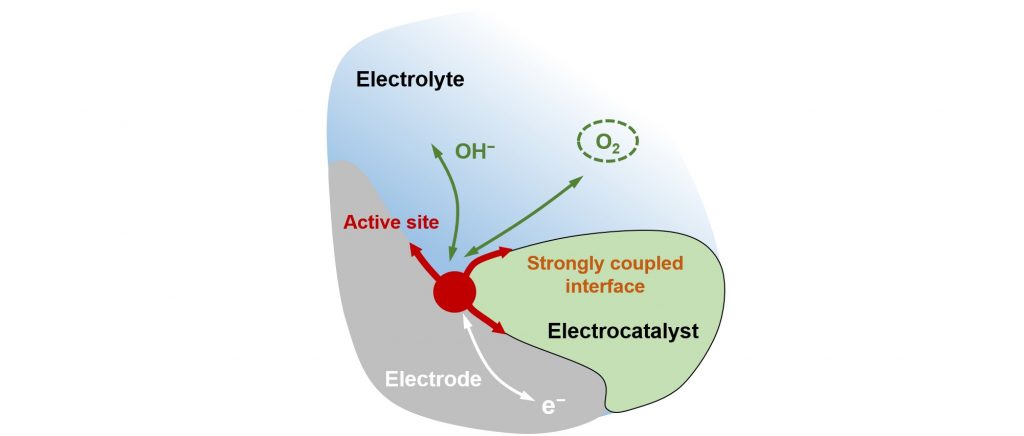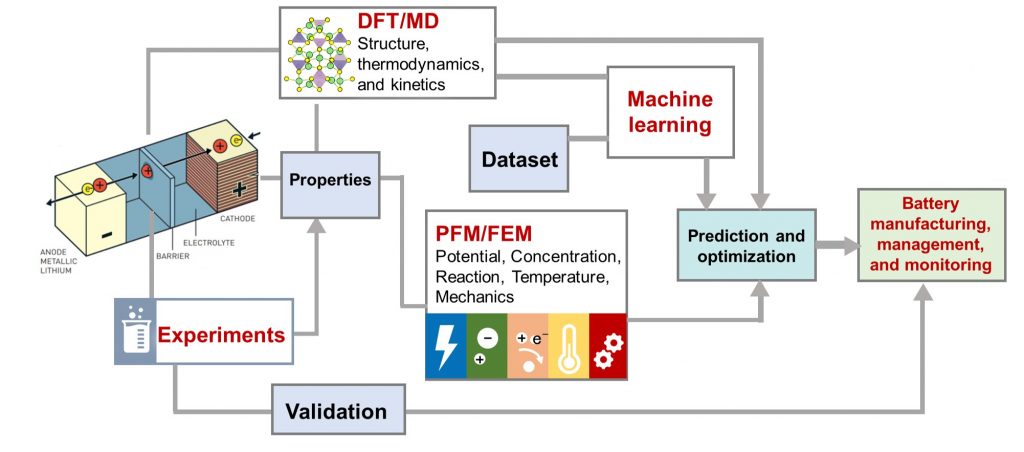Energy storage technology is a key supporting pillar for the energy revolution and achieving carbon peak and carbon neutrality. The development of energy storage technology is an important means to promote the integration and consumption of clean energy such as wind and solar energy, which account for a large proportion of total renewable energy. It is also essential to develop the energy storage technology to improve the independent controllability of key equipments and systems, so as to realize energy security and energy structure transformation of our country.
With the goal of sustainable development, our research group is engaged in innovative research in fields of energy materials and energy chemistry, especially involving lithium metal anodes, lithium–sulfur batteries, and electrocatalysis. The specific research work includes:
(1) Lithium metal batteries and energy chemistry: Lithium bond chemistry, ion–solvent complex, and chemistry about lithium metal and electrolytes
The energy chemistry of lithium is the core foundation of the energy conversion and storage process of lithium batteries. We seek to understand and explore the energy chemistry of lithium at electronic, atomic, molecular, and material scale, including the existence state, the interactions with other atoms and molecules, transport mechanism, thermodynamic and kinetic features of (electro-) chemical reactions, and temporal and spatial behavior of the lithium atom or ion in lithium batteries by developing theoretical and experimental tools. We focus on the theory of lithium bond, solvation chemistry in electrolytes, the formation process of electrode/electrolyte interphase, and the charge transfer mechanism, aiming to provide guidance for the design of electrodes, electrolytes, and electrode/electrolyte interphases.

(2) Lithium metal anodes: Highly safe, high-energy density, and long-cycling composite lithium metal anodes and solid-state batteries
Lithium metal anode is the basic material of high-energy-density rechargeable batteries. Stable lithium metal anode is the key to promote practical applications of high-safety and high-energy-density batteries. We seek to disclose the key issues hindering the stability of lithium metal anodes under practical conditions. We develop the design of the structure of composite anodes, lithiophilic materials, novel liquid electrolytes, and artificial interphases to construct long-cycling and high-specific-capacity composite lithium anodes. We explore strategies to achieve high-energy-density lithium pouch cells based on liquid, solid-state, and all-solid-state electrolytes to promote the applications of lithium metal batteries.

(3) Lithium–sulfur batteries: Long-cycling, low-cost, and high-energy-density lithium–sulfur batteries
Lithium–sulfur batteries are highly considered as promising next-generation energy storage technology due to the ultrahigh theoretical energy density of 2600 Wh kg−1. Focusing on the key electrochemical process, we conduct a series of researches on exploring the reaction mechanisms and regulation strategies, including constructing cathode skeletons to promote electron/ion conductivity, designing homogeneous/heterogeneous kinetic promoters to boost the sulfur redox kinetics, regulating the solvation structure of polysulfides to improve reaction reversibility, and protecting lithium metal anodes by inhibiting side reactions. We expect to realize practical lithium–sulfur pouch cells with high energy density and long lifespan and provide new understanding on reaction mechanisms, regulation strategies, and macroscopic applications of lithium–sulfur batteries.

(4) Energy and electrocatalysis: Zinc–air batteries, oxygen reduction and oxidation catalysts, three-phase electrocatalysis
Rechargeable zinc–air batteries have attracted intensive attentions because of their high energy density, low cost, environmental friendliness, and safety, whose actual performances are severely limited by the sluggish kinetics of the cathodic oxygen reduction and evolution reactions at the three-phase interfaces. To address the above issue, we propose the anionic regulation strategy and develop a series of precise synthesis methods to promote the intrinsic activity of noble-metal-free electrocatalysts. We also design strongly coupled interfaces to promote interfacial electron transfer and hierarchical cathode structures to construct high-performance noble-metal-free bifunctional oxygen electrocatalysts, which can make zinc–air batteries capable of cycling stably at high rate and high capacity.

(5) Machine-learning assisted functional material design
The rapid development of computer technology has greatly promoted the new paradigm of energy material design based on big data, which is expected to greatly reduce the time and expense of material design. On one hand, we aim to build a multi-scale simulation method based on density functional theory, molecular dynamics simulations, and phase field theory to establish a large database of energy material systems at the molecular level and quantitatively understand the structure–function relationship of functional materials, so as to realize the rational design and high-throughput screening of energy materials. On the other hand, based on the understanding of the micro-mechanism of the energy system related to lithium batteries, the combination of theory and experiments are supposed to accurately predict battery cycle life and battery performance at high and low temperatures.
